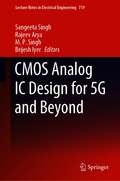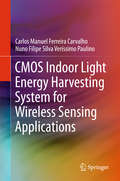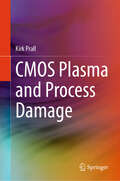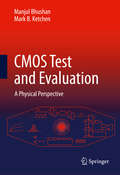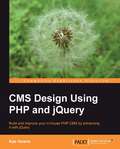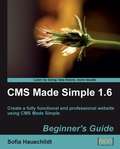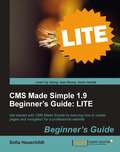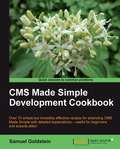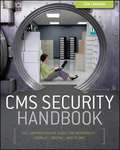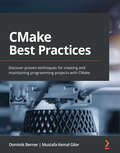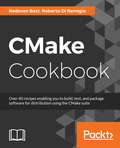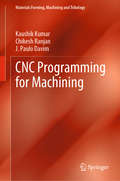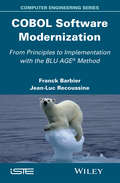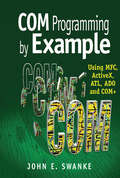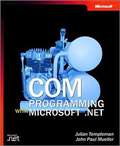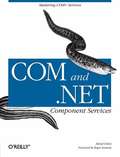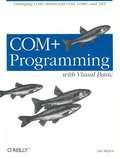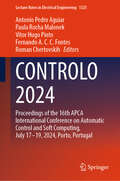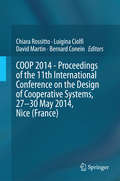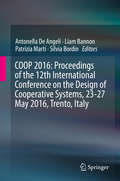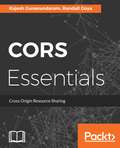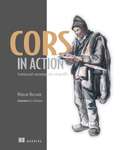- Table View
- List View
CMOS Analog IC Design for 5G and Beyond (Lecture Notes in Electrical Engineering #719)
by Brijesh Iyer Rajeev Arya Sangeeta Singh M. P. SinghThis book is focused on addressing the designs of FinFET-based analog ICs for 5G and E-band communication networks. In addition, it also incorporates some of the contemporary developments over different fields. It highlights the latest advances, problems and challenges and presents the latest research results in the field of mm-wave integrated circuits designing based on scientific literature and its practical realization. The traditional approaches are excluded in this book. The authors cover various design guidelines to be taken care for while designing these circuits and detrimental scaling effects on the same. Moreover, Gallium Nitrides (GaN) are also reported to show huge potentials for the power amplifier designing required in 5G communication network. Subsequently, to enhance the readability of this book, the authors also include real-time problems in RFIC designing, case studies from experimental results, and clearly demarking design guidelines for the 5G communication ICs designing. This book incorporates the most recent FinFET architecture for the analog IC designing and the scaling effects along with the GaN technology as well.
CMOS Indoor Light Energy Harvesting System for Wireless Sensing Applications
by Carlos Manuel Ferreira Carvalho Nuno Filipe Silva Veríssimo PaulinoThis book discusses in detail the CMOS implementation of energy harvesting. The authors describe an integrated, indoor light energy harvesting system, based on a controller circuit that dynamically and automatically adjusts its operation to meet the actual light circumstances of the environment where the system is placed. The system is intended to power a sensor node, enabling an autonomous wireless sensor network (WSN). Although designed to cope with indoor light levels, the system is also able to work with higher levels, making it an all-round light energy harvesting system. The discussion includes experimental data obtained from an integrated manufactured prototype, which in conjunction with a photovoltaic (PV) cell, serves as a proof of concept of the desired energy harvesting system.
CMOS Plasma and Process Damage
by Kirk PrallThis book discusses the complex technology of building CMOS computer chips and covers some of the unusual problems that can occur during chip manufacturing. Readers will learn how plasma and process damage results from the high-energy processes that are used in chip manufacturing, causing harm to the chips, functional failure and reliability problems.
CMOS Test and Evaluation: A Physical Perspective
by Mark B. Ketchen Manjul BhushanCMOS Test and Evaluation: A Physical Perspective is a single source for an integrated view of test and data analysis methodology for CMOS products, covering circuit sensitivities to MOSFET characteristics, impact of silicon technology process variability, applications of embedded test structures and sensors, product yield, and reliability over the lifetime of the product. This book also covers statistical data analysis and visualization techniques, test equipment and CMOS product specifications, and examines product behavior over its full voltage, temperature and frequency range.
CMS Design Using PHP and jQuery
by Kae VerensThis is a practical, tutorial-style book that develops a project from start to finish, explaining all aspects of the project. Every chapter starts by explaining what is to be accomplished and the various ways in which the problem may be tackled, followed by an in-depth explanation of the chosen solution. If you want to see jQuery in action with PHP and MySQL code, in the context of a real application, this is the book for you. It is written for developers who have written multiple scripts or websites, and want to know how to combine them all into one package that can be used to simplify future scripts and sites. The book is aimed at people who understand the basics of PHP and jQuery, and want to know how they can be used effectively to create a large project that is user-friendly and flexible.
CMS Made Simple 1.6: Beginner's Guide
by Sofia HauschildtThis is a practical, hands-on book based around a case study website, which you will build in this easy-to-understand workshop by using CMS Made Simple. The case study grows chapter by chapter, from CMS installation to the finished website. It provides clear instructions and detailed screenshots, so you can see exactly what to do at each step of the build. When you have completed the case study, you will have the knowledge and confidence to build a website with rich functionality and individual design that is optimized for search engines and can be handed over to the customer. This book is perfect for newcomers as well as webmasters who are looking for an introduction to building powerful and professional websites with a content management system. Basic knowledge of HTML and CSS is the only requirement. The workshop covers all aspects of web publishing and is aimed for web designers, web developers, editors, and web managers.
CMS Made Simple 1.9 Beginner?s Guide: LITE Edition
by Sofia HauschildtThis is a practical, hands-on book based around a case study website, which you will set up in this easy-to-understand introduction to using CMS Made Simple. The chapters provide clear instructions and detailed screenshots, so you can see exactly what to do at each step of the build. This book is perfect for newcomers as well as webmasters who are looking for an introduction to building powerful and professional websites with a content management system. The workshop covers all aspects of web publishing and is aimed for web designers, web developers, editors, and web managers.
CMS Made Simple Development Cookbook
by Samuel GoldsteinThis is a cookbook, with practical recipes providing tips and tricks to the most common problems and scenarios faced with CMS Made Simple Development.If you are a CMS Made Simple user wanting to expand your skill set, or a programmer who wants to develop for CMS Made Simple, this book is for you. You will need working knowledge of PHP, HTML, and SQL. Some experience with CMS Made Simple is recommended.
CMS Security Handbook
by Tom CanavanLearn to secure Web sites built on open source CMSs Web sites built on Joomla!, WordPress, Drupal, or Plone face some unique security threats. If you're responsible for one of them, this comprehensive security guide, the first of its kind, offers detailed guidance to help you prevent attacks, develop secure CMS-site operations, and restore your site if an attack does occur. You'll learn a strong, foundational approach to CMS operations and security from an expert in the field. More and more Web sites are being built on open source CMSs, making them a popular target, thus making you vulnerable to new forms of attack This is the first comprehensive guide focused on securing the most common CMS platforms: Joomla!, WordPress, Drupal, and Plone Provides the tools for integrating the Web site into business operations, building a security protocol, and developing a disaster recovery plan Covers hosting, installation security issues, hardening servers against attack, establishing a contingency plan, patching processes, log review, hack recovery, wireless considerations, and infosec policy CMS Security Handbook is an essential reference for anyone responsible for a Web site built on an open source CMS.
CMake Best Practices: Discover proven techniques for creating and maintaining programming projects with CMake
by Dominik Berner Mustafa Kemal GilorExplore a compendium of tips, tricks, and techniques for leveraging CMake and empowering your software development workflow.Key FeaturesUnderstand what CMake is, how it works, and how to interact with itDiscover how to properly create and maintain well-structured CMake projectsExplore tools and techniques to get the most out of your CMake projectBook DescriptionCMake is a powerful tool used to perform a wide variety of tasks, so finding a good starting point for learning CMake is difficult. This book cuts to the core and covers the most common tasks that can be accomplished with CMake without taking an academic approach. While the CMake documentation is comprehensive, it is often hard to find good examples of how things fit together, especially since there are lots of dirty hacks and obsolete solutions available on the internet. This book focuses on helping you to tie things together and create clean and maintainable projects with CMake.You'll not only get to grips with the basics but also work through real-world examples of structuring large and complex maintainable projects and creating builds that run in any programming environment. You'll understand the steps to integrate and automate various tools for improving the overall software quality, such as testing frameworks, fuzzers, and automatic generation of documentation. And since writing code is only half of the work, the book also guides you in creating installers and packaging and distributing your software. All this is tailored to modern development workflows that make heavy use of CI/CD infrastructure.By the end of this CMake book, you'll be able to set up and maintain complex software projects using CMake in the best way possible.What you will learnGet to grips with architecting a well-structured CMake projectModularize and reuse CMake code across projectsIntegrate various tools for static analysis, linting, formatting, and documentation into a CMake projectGet hands-on with performing cross-platform buildsDiscover how you can easily use different toolchains with CMakeGet started with crafting a well-defined and portable build environment for your projectWho this book is forThis book is for software engineers and build system maintainers working with C or C++ on a regular basis and trying to use CMake to better effect for their everyday tasks. Basic C++ and general programming knowledge will help you to better understand the examples covered in the book.
CMake Cookbook: Building, testing, and packaging modular software with modern CMake
by Radovan Bast Roberto Di Remigio<P><P><i>Advisory: Bookshare has learned that this book offers only partial accessibility. We have kept it in the collection because it is useful for some of our members. Benetech is actively working on projects to improve accessibility issues such as these.</i> Learn CMake through a series of task-based recipes that provide you with practical, simple, and ready-to-use CMake solutions for your codeKey FeaturesLearn to configure, build, test, and package software written in C, C++, and FortranProgress from simple to advanced tasks with examples tested on Linux, macOS, and WindowsManage code complexity and library dependencies with reusable CMake building blocks <P><P>Book Description <br>CMake is cross-platform, open-source software for managing the build process in a portable fashion. This book features a collection of recipes and building blocks with tips and techniques for working with CMake, CTest, CPack, and CDash. <P><P>CMake Cookbook includes real-world examples in the form of recipes that cover different ways to structure, configure, build, and test small- to large-scale code projects. You will learn to use CMake's command-line tools and master modern CMake practices for configuring, building, and testing binaries and libraries. With this book, you will be able to work with external libraries and structure your own projects in a modular and reusable way. You will be well-equipped to generate native build scripts for Linux, MacOS, and Windows, simplify and refactor projects using CMake, and port projects to CMake. <P><P>What you will learn <P>Configure, build, test, and install code projects using CMake <br>Detect operating systems, processors, libraries, files, and programs for conditional compilation <br>Increase the portability of your code <br>Refactor a large codebase into modules with the help of CMake <br>Build multi-language projects <br>Know where and how to tweak CMake configuration files written by somebody else <br>Package projects for distribution <br>Port projects to CMake <P><P>Who this book is for <P><P>If you are a software developer keen to manage build systems using CMake or would like to understand and modify CMake code written by others, this book is for you. A basic knowledge of C++, C, or Fortran is required to understand the topics covered in this book.
CNC Programming for Machining (Materials Forming, Machining and Tribology)
by J. Paulo Davim Kaushik Kumar Chikesh RanjanThe book is basically written with a view to project Computer Numerical Control Programming (CNC) Programming for machines. This book shows how to write, read and understand such programs for modernizating manufacturing machines. It includes topics such as different programming codes as well as different CNC machines such as drilling and milling.
COBOL Software Modernization
by Jean-Luc Recoussine Franck BarbierNowadays, billions of lines of code are in the COBOL programming language. This book is an analysis, a diagnosis, a strategy, a MDD method and a tool to transform legacy COBOL into modernized applications that comply with Internet computing, Service-Oriented Architecture (SOA) and the Cloud. It serves as a blueprint for those in charge of finding solutions to this considerable challenge.
COM Programming by Example: Using MFC, ActiveX, ATL, ADO, and COM+
by John SwankeUse MFC, ActiveX, ATL, ADO and COM+ to develop COM applications Implement client/server applications with ease with this example-oriented approach to the details and implementation of COM technology in network applications. If there was ever a subject th
COM Programming with Microsoft® .NET
by Julian Templeman John Paul MuellerMicrosoft .NET is here, but COM and COM+ will be a valuable part of every Microsoft Windows® programmer's toolbox for years. This in-depth programming guide explains how and where COM and COM+ fit into the new .NET world, demonstrates the new technologies that are available in .NET, and shows how to interoperate between COM/COM+ and .NET. It explains how to use Microsoft Visual Studio® .NET to write traditional COM objects, how to use COM objects in .NET code, and how to use .NET objects as COM objects. It also discusses COM+ topics such as disconnected applications and subscriptions. The authors show you both theoretical and practical approaches--explaining how the mechanisms work and also providing practical advice with sample code to show how to handle interoperability. Topics covered include: The .NET view of COM and COM+ COM, COM+, and .NET Using COM components in .NET code Using .NET components in COM applications Overview of COM+ coding for .NET Writing COM code Attributed programming Active Template Library (ATL) and ATL Server Writing COM+ code A simple COM+ example Working with disconnected applications Creating subscriptions Web application scenarios Interoperability Interacting with unmanaged code Advanced interaction Working with predefined interfaces Includes sample code on the Web
COM and .NET Component Services
by Juval LowyCOM and .NET Component Services provides both traditional COM programmers and new .NET component developers with the information they need to begin developing applications that take full advantage of COM+ services. This book focuses on COM+ services, including support for transactions, queued components, events, concurrency management, and security.
COM and .NET Component Services
by Juval LowyWith COM and .NET Component Services, skilled COM developers can leverage their knowledge for the next generation of components to be built for Microsoft's new .NET framework. A primary goal of Microsoft's COM+ is to provide proven design solutions for scalable systems. Assuming experience with classic COM, COM and .NET Component Services focuses on the added services of COM+, including support for transactions, queued components, events, concurrency management, and security. Along the way, it ably demonstrates that COM+ is a masterpiece of design and usability from the ground up--truly a mature set of component services oriented for the middle tier. COM+ provides a foundation for robust, enterprise-wide, mission-critical distributed applications. And it's not limited to Internet applications. You can use COM+ services in the same places as classic COM components: in-house two-tier information systems, client-tier controls, desktop applications, machine control components, and every other conceivable application of COM. COM and .NET Component Services is the first book to stress the importance of learning to use COM+ services for both .NET and COM component-based applications. Since most companies have considerable investment in existing code base and development skills, COM+ can serve as a migration path for companies and developers. Companies can start (or continue) their projects in COM, using COM+ as a supporting platform for component services, and then when the time comes to move to .NET, they can start plugging .NET components seamlessly into the same architecture, reusing and interacting with their existing COM components.
COM+ Programming with Visual Basic
by Jose MojicaCOM+ Programming with Visual Basic draws from the author's wide experience as a COM+ developer and instructor. The first part shows you how to create robust, efficient, high-performance COM+ applications. The second focuses on incorporating individual COM+ services, like transaction support, security, and asynchronous operations, into applications. Not for beginners, this book reveals how COM+ really works, as well as how to make COM+ components work with the upcoming Microsoft .NET architecture.
COM+ Programming with Visual Basic
by Jose MojicaThe importance of a book like COM+ Programming with Visual Basic lies in the fact that the Visual Basic programming environment is designed to hide as many low-level system details as possible. While this approach can speed development time by letting you focus on the task at hand, it actually hinders the process when it obscures details you need to understand or control. Such is often the case for programmers who are developing components that take advantage of COM+ services. COM+ Programming with Visual Basic takes aim squarely at the information needs of these developers. For instance, despite the marketing hype about COM+ as the new and improved version of COM, classic COM is very much the foundation on which COM+ is built: COM+ components are a particular kind of COM component. Visual Basic hides almost all COM implementation details; yet it is precisely in the area of COM+ programming that these hidden details are most important. Therefore, we've devoted significant content to exploring COM internals: Interface-based programming How COM interfaces work internally How COM components are activated How versioning COM components works in Visual Basic How to use interfaces Passing objects by reference or by value What it means to have multithreaded applications How declarative programming works How to program within a distributed transaction How to add role-based security to applications The second section focuses on incorporating individual COM+ services, like transaction support, security, and asynchronous operations, into applications. The author concludes by discussing what you need to learn to transition to Microsoft's coming .NET framework. Regardless of what lies ahead for .NET, many distributed systems are being built today with COM+. COM+ Programming with Visual Basic focuses on topics relevant to distributed applications that are here to stay: There's simply no other documentation available for much of what's in COM+ Programming with Visual Basic. It's destined to be the resource behind the most robust, efficient, high-performance COM+ applications.
COMMENT CRÉER UNE ENTREPRISE EN LIGNE EN 7 ÉTAPES (1 #1)
by Tolga CakirCe livre révélera des stratégies pratiques conçues pour aider les lecteurs qui voudraient lancer une entreprise en ligne mais ne savent pas par où commencer. Tolga Cakir a écrit ce livre comme le premier volume qui est dans un langage simple visant à aider les lecteurs non professionnels du monde entier.
CONTROLO 2024: Proceedings of the 16th APCA International Conference on Automatic Control and Soft Computing, July 17-19, 2024, Porto, Portugal (Lecture Notes in Electrical Engineering #1325)
by Paula Rocha Malonek Antonio Pedro Aguiar Vítor Hugo Pinto Fernando A. C. C. Fontes Roman ChertovskihThis book offers a perfect insight of the latest research and developments in the fields of dynamic systems and control engineering. Gathering the proceedings of the 16th APCA International Conference on Automatic Control and Soft Computing (CONTROLO 2024), held on July 17-19, 2024, in Porto, Portugal, this volume covers a wide range of theoretical and practical issues relating to the development and use of different control approaches, such as PID control, adaptive control, non-linear control, intelligent monitoring and control based on fuzzy and neural systems. Further topics include robust control systems, and real time control. Sensors and actuators, measurement systems, renewable energy systems, aeronautic and aerospace systems, as well as industrial control and automation, are also comprehensively covered. All in all, this book offers a timely and thoroughly survey of the latest research in the fields of dynamic systems and automatic control engineering, and a source of inspiration for researchers and professionals worldwide.
COOP 2014 - Proceedings of the 11th International Conference on the Design of Cooperative Systems, 27-30 May 2014, Nice (France)
by David Martin Luigina Ciolfi Chiara Rossitto Bernard ConeinThis volume presents the proceedings of the 11th International Conference on the Design of Cooperative Systems (COOP 2014). The conference is a venue for multidisciplinary research contributing to the design, assessment and analysis of cooperative systems and their integration in organizations, public venues, and everyday life. COOP emerged from the European tradition of Computer Supported Cooperative Work (CSCW) and Cognitive Ergonomics as practiced in France These proceedings are a collection of 28 papers reflecting the variety of research activities in the field, as well as an increasing interest in investigating the use and design of ICT in all aspects of everyday life and society, and not merely in the workplace. The papers represent a variety of research topics, from healthcare to sustainable mobility to disaster response, in settings from all over the world. For the first time, the proceedings include papers presented in an Early-Career Researchers Track which was organized in order to give young researchers the opportunity to discuss their work with an international community. This collection of papers provides a picture of new developments and classic topics of research around cooperative systems, based on the principle that a deep knowledge of cooperative practices is a key to understanding technology impacts and producing quality designs. The articles presented will appeal to researchers and practitioners alike, as they combine an understanding of the nature of work with the possibilities offered by novel digital technologies.
COOP 2016: Proceedings of the 12th International Conference on the Design of Cooperative Systems, 23-27 May 2016, Trento, Italy
by Antonella De Angeli Liam Bannon Patrizia Marti Silvia BordinThis volume presents the proceedings of the 12th International Conference on the Design of Cooperative Systems (COOP 2016). The conference is a venue for multidisciplinary research contributing to the design, assessment and analysis of cooperative systems and their integration in organizations, public venues, and everyday life. COOP emerged from the European tradition of Computer Supported Cooperative Work (CSCW) and Cognitive Ergonomics. A collection of 22 papers and 4 workshop overviews are presented, reflecting the variety of research activities in the field of the design of cooperative systems with a special emphasis on "Making Together" This collection offers a broad vision of collective working practices and cooperative design, embracing the idea that design requires a deep understanding of collective activities, involving both artefacts and social practices within a context. The result is a rich and articulated debate that widens the design space towards the exploration of a variety of forms of participation and engagement in collaborative system design. Experienced researchers, academics, designers and practitioners who are interested in collaborative design theory and methods would be interested in the state of the art research and case studies this collection provides.
CORS Essentials
by Rajesh Gunasundaram Randall GoyaWeb developers have been limited by the Same Origin Policy and often wish they could spread their application across different domains. You know JavaScript and AJAX, and have run up against the Same Domain Policy, which is limiting your applications.
CORS in Action: Creating and consuming cross-origin APIs
by Monsur HossainSummaryCORS in Action introduces Cross-Origin Resource Sharing (CORS) from both the server and the client perspective. It starts with the basics: how to make CORS requests and how to implement CORS on the server. It then explores key details such as performance, debugging, and security. API authors will learn how CORS opens their APIs to a wider range of users. JavaScript developers will find valuable techniques for building rich web apps that can take advantage of APIs hosted anywhere. The techniques described in this book are especially applicable to mobile environments, where browsers are guaranteed to support CORS. Purchase of the print book includes a free eBook in PDF, Kindle, and ePub formats from Manning Publications. About the BookSuppose you need to share some JSON data with another application or service. If everything is hosted on one domain, it's a snap. But if the data is on another domain, the browser's "same-origin" policy stops you cold. CORS is a new web standard that enables safe cross-domain access without complex server-side code. Mastering CORS makes it possible for web and mobile applications to share data simply and securely. CORS in Action introduces CORS from both the server and the client perspective. It starts with making and enabling CORS requests and then explores performance, debugging, and security. You'll learn to build apps that can take advantage of APIs hosted anywhere and how to write APIs that expand your products to a wider range of users. For web developers comfortable with JavaScript. No experience with CORS is assumed.What's InsideCORS from the ground upServing and consuming cross-domain dataBest practices for building CORS APIsWhen to use CORS alternatives like JSON-P and proxiesAbout the AuthorMonsur Hossain is an engineer at Google who has worked on API-related projects such as the Google JavaScript Client, the APIs Discovery Service, and CORS support for Google APIs.Table of ContentsPART 1 INTRODUCING CORSThe Core of CORSMaking CORS requestsPART 2 CORS ON THE SERVERHandling CORS requestsHandling preflight requestsCookies and response headersBest practicesPART 3 DEBUGGING CORS REQUESTSDebugging CORS requests APPENDIXESCORS referenceConfiguring your environmentWhat is CSRF?Other cross-origin techniques
